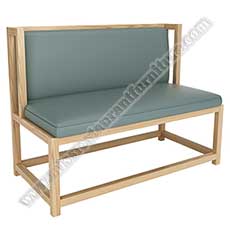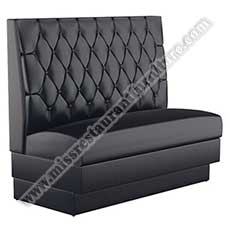Restaurant Booths: Are they right for your eatery?
--Shenzhen Miss Restaurant Furniture Co.,Ltd
“Can we have a booth, please?” If you’ve ever been a host/hostess at a restaurant, you have heard that request more than just once or twice. Those dining out often prefer sitting at a comfortable restaurant booths. Here’s why we believe booths fit almost any restaurant seating design:
Maximize space. restaurant booths seating which has guests back-to-back requires less space, because you don’t have to allow for the room for guests to pull chairs in or out or walk in between back-to-back chairs. The overall footprint of a booth tends to be less than a table and chair configuration.
Create privacy. There are a lot of reasons people love dining out, but if they sit in a sea of open tables with strangers chomping down their food an arm length’s away, they feel uncomfortable. Give them the privacy to carry on their own conversations. Naturally, people like their own personal space, and booths create barriers between tables and the other people in the restaurant.
Use a wall – or don’t. Most people think that booths have to be against a wall and tables with chairs are the only seating that can float in the middle of the room. Not true! Create a row of booths down the center of a room, or use the finished backs of a line of single booths to create a room divider – and a long aisle of seating. The design possibilities are really endless, if you are open to trying something a little less traditional in your restaurant design. However, if you like the look of booths up against a wall, that positioning, of course, works well, too! Your restaurant layout is up to you!
Offer kid-approved seating.When used against a wall, though, restaurant booths are proven to be family-friendly, as grown-ups can “trap” their rambunctious youngsters into the booth by sandwiching their tots between them and the wall. Plus booths allow a little wiggle room, and are usually more comfortable for a child than a traditional chair designed for an adult.

Upsell, upsell, upsell. In addition, using a wall to “anchor” a table could increase dollars spent per party. People who sit at anchored tables, or booths against a wall, tend to feel “out of the way” from your other busy areas and stay longer. Sales at anchored tables are more likely to include an appetizer and a dessert than free-standing tables near busy areas, like an entrance/exit, a waitress station, the kitchen, or a bus station.
Be flexible. A family of five arrives at the busiest dinner time, and you don’t have tables of a 4-seater and a 2-seater available to push together, but you do have an open booth. Chances are, even if you make it a habit to only seat four people in a booth at a time, that family will be able to squish together their smallest and be just fine. Because there is no set number of seats in each booth bench, your seating automatically becomes flexible, especially among families with youth. They may actually prefer the booth, which means you only use one table instead of two.
Choose class. Restaurant booths can be very basic or upscale. They go great in pizzerias and fast food joints, or they can be added as seating at a fine dining restaurant. Custom designs allow for the right look for your place, so you can make sure they match your atmosphere and meet customer expectations based on your level of quality and service.
Choose style. With so many color and style options, matching your restaurant’s decor will be easy! You may choose an all wooden look, an all vinyl upholstery look, a combination like vinyl seats and a wooden back, or just add some wood trim to your vinyl booth. Both wooden booths and vinyl booths offer several color options. Choose your wood finish or your upholstery color to match your other restaurant furniture and overall design. Restaurant booth styles are truly endless and can also be customized, so find the right one for you!
Most restaurants offer a mix of restaurant booths with restaurant tables and restaurant chairs for a balanced seating solution. Some also use banquette seating, which places a booth bench on one side of the table and chairs on the opposite side. Keep your customers in mind, and give them the restaurant seating they prefer.
TAGS: WOOD RESTAURANT TABLES, ROUND RESTAURANT TABLES, COFFEE TABLES, WOOD RESTAURANT CHAIRS, UPHOLSTERED RESTAURANT CHAIRS, RETRO DINER CHAIRS, WOOD BAR STOOLS, RETRO DINER BOOTHS, LEATHER RESTAURANT BOOTHS, RESTAURANT BACK TO BACK BOOTHS, RESTAURANT CORNER BOOTHS, WOOD RESTAURANT TABLE AND CHAIRS, WOOD RESTAURANT TABLE AND BOOTHS, RESTAURANT TABLE TOPS, RESTAURANT TABLE BASES, AND SO ON.












